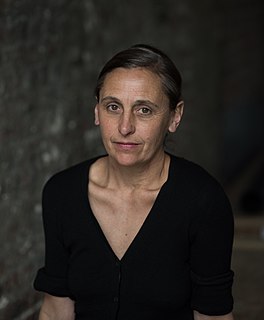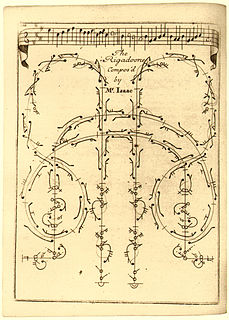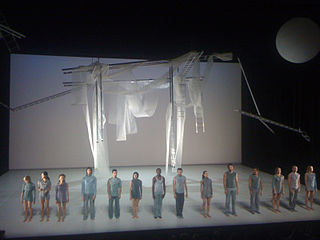Related Research Articles

A country dance is any of a very large number of social dances of a type that originated in the British Isles; it is the repeated execution of a predefined sequence of figures, carefully designed to fit a fixed length of music, performed by a group of people, usually in couples, in one or more sets. The figures involve interaction with your partner and/or with other dancers, usually with a progression so that you dance with everyone in your set. It is common in modern times to have a "caller" who teaches the dance and then calls the figures as you dance.
In dance, choreography is the act of designing dance. Choreography may also refer to the design itself, which is sometimes expressed by means of dance notation. A choreographer is one who creates dances. Dance choreography is sometimes called dance composition.
Contact improvisation is a form of improvised dancing that has been developing internationally since 1972. It involves the exploration of one's body in relationship to others by using the fundamentals of sharing weight, touch, and movement awareness.

Contemporary dance is a genre of dance performance that developed during the mid-twentieth century and has since grown to become one of the dominant genres for formally trained dancers throughout the world, with particularly strong popularity in the U.S. and Europe. Although originally informed by and borrowing from classical, modern, and jazz styles, it has come to incorporate elements from many styles of dance. Due to its technical similarities, it is often perceived to be closely related to modern dance, ballet, and other classical concert dance styles.
Judson Dance Theater was a collective of dancers, composers, and visual artists who performed at the Judson Memorial Church in Greenwich Village, Manhattan New York City between 1962 and 1964. The artists involved were avant garde experimentalists who rejected the confines of Modern dance practice and theory, inventing as they did the precepts of Postmodern dance.

Anne Teresa, Baroness De Keersmaeker is a contemporary dance choreographer. The dance company constructed around her, Rosas, was in residence at La Monnaie in Brussels from 1992 to 2007.

Raoul AugerFeuillet (c.1660–1710) was a French dance notator, publisher and choreographer most well-known today for his Chorégraphie, ou l'art de décrire la danse which described Beauchamp–Feuillet notation, and his subsequent collections of ballroom and theatrical dances, which included his own choreographies as well as those of Pécour.

Pierre Beauchamp (also Beauchamps was a French choreographer, dancer and composer, and the probable inventor of Beauchamp–Feuillet notation. His grand-father was called Christophe and his father, a violonist of the king's chamber, was simply called Louis. Following a custom of the time, Pierre Beauchamp was named Pierre after his godfather Pierre Vacherot, tailor of the queen's pages and a relative of the Beauchamps family. See Regine Kunzle and John Powell Powell, John S. “Pierre Beauchamps, Choreographer to Molière's Troupe Du Roy.” Music & Letters, vol. 76, no. 2, 1995, pp. 168–186. JSTOR, www.jstor.org/stable/737729. Accessed 4 Nov. 2020.
Pierre Droulers is a French and Belgian choreographer and dancer.

Wim Vandekeybus is a Belgian choreographer, director and photographer. His company Ultima Vez is located in Sint-Jans-Molenbeek (Brussels). Together with Jan Fabre, Alain Platel and Anne Teresa De Keersmaeker, Wim Vandekeybus has been responsible for the Flemish Wave in contemporary dance in the 80's. He made over thirty international dance and theater productions and almost as many movies and video works.
Thierre De Mey is a musician and filmmaker from Belgium.

Frédéric Flamand is a Belgian actor, director, and choreographer.
Thomas Hauert is a Swiss dancer and choreographer, leader of the Brussels-based company ZOO/Thomas Hauert.
Iro Tembeck (1946–2004) was a Canadian dancer, choreographer, and dance historian. After emigrating to Montreal in 1967, she taught at the academy of Les Grands Ballets Canadiens, and danced with Le Groupe Nouvelle Aire in the early 1970s. She founded Axis Danse with Christina Coleman in 1977, and in 1980, Tembeck became a professor in the Dance Department at Université du Québec à Montréal, where she also co-founded the choreographic research group Artscene. Tembeck signed over 40 choreographic works, which were produced with Le Groupe Nouvelle Aire, Axis Danse, Les Ballets Jazz de Montréal, and Les Ballets Eddy Toussaint.

Wilfride Piollet was a French ballerina and choreographer. She was born in Saint-Rambert-d'Albon. Her philosophy of dance and her research led to the publication of several books. Piollet joined the Paris Opera Ballet company in 1960. She gained the rank "coryphée" in 1963, "sujet" in 1964, soloist in 1966, and was promoted to principal dancer (étoile) in 1969. In 1973, Nouvelle lune c-à-d was created for her retirement of the Paris Opera. Invited as a guest by Rudolf Nureyev, she danced at the Paris Opera until 1990, the year when Jean Guizerix left. At the Paris Opera and worldwide, she performed the classical, neo-classical and contemporary repertory, and from the 1980s, the Baroque and Renaissance ones. She ended her dance career in 2003 with a piece on Isadora Duncan's dances studied with Madeleine Lytton, and performed with Jean Guizerix.
The Mudra Afrique was a contemporary dance school founded in Dakar, Senegal in 1977 by Léopold Sédar Senghor and Maurice Béjart, based on a Pan-African philosophy of uniting Africans through the commonalities in the different ways of artistic self-expression throughout the continent, thus creating a universal artistic culture that challenges the dominance of European dance and artistry. The school closed in 1983 but a significant number of its students went on to successful international careers., such as the Burkinabe choreographer, dancer, actor and artist Irene Tassembedo. Mudra Afrique played a crucial role in preparing the basis for contemporary African dance by training the first generation of “modern” African dancers according to international artistic standards.
Laurence Louppe was a French writer, critic and historian of dance, a specialist in the aesthetics of dance and visual arts and a choreographic artist.
Lisa Nelson is an American dance-maker, improviser, videographer, and collaborative artist. She was born in New York City in 1949 and currently lives in Northern Vermont.
Eleanor Bauer is an American choreographer and dancer.
Elizabeth Langley is a Performer, Choreographer, Teacher, Dramaturge, Creation & Rehearsal Director, Designer of a BFA Contemporary Dance Degree in the Contemporary Dance Department at Concordia University, Montreal, Canada..
References
- ↑ Meurrens, Contredanse A.S.B.L. - Isabelle. "Contredanse ASBL - Contredanse A.S.B.L." www.contredanse.org.
- ↑ "Early Dance Circle Home Page". 16 February 2012. Archived from the original on 16 February 2012.
- 1 2 Meurrens, Contredanse A.S.B.L. - Isabelle. "Contredanse ASBL - Contredanse A.S.B.L." www.contredanse.org.
- ↑ Esterzon, Alain. "NDD L'actualité de la danse - Revues.be". www.revues.be.